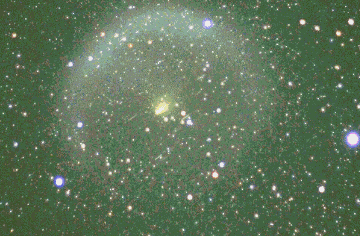Rocket Explodes Over Australia, Showers Space with Debris

This story was updated at 4:30 pm ET.
Debris from a rocket booster that exploded in space into more than 1,000 pieces has been spotted over Western Australia.
The debris belonged to a derelict rocket booster, called the Breeze-M, that sat atop a Russian Proton rocket carrying an Arabsat-4A communications satellite launched on Feb. 28, 2006. Shortly after liftoff, the rocket malfunctioned, leaving the satellite in the wrong orbit and the Breeze-M floating in space.
"It was left in an elliptical orbit with pretty much a full tank of fuel aboard," said Mark Matney of NASA's Orbital Debris Office.
On Feb. 19, 2007, the rocket booster exploded for unknown reasons over Australia.
"It had hypergolic fuels aboard, which tend to be kind of corrosive," Matney told SPACE.com. "That may be it. It's always a possibility that it was a micrometeor or debris hit, but most probably it was just a spontaneous failure."
Radar has since detected about 1,111 debris fragments [image] from the rocket, Jon Boers of the United States Air Force Space (USAF) Surveillance System told the website SpaceWeather.com, where the story was first reported.
Breaking space news, the latest updates on rocket launches, skywatching events and more!
"We see this all the time, where rocket bodies left with fuel on board spontaneously explode," Matney said.
However, he added that the Breeze-M explosion was "a very big breakup, certainly one of the largest."
The amount of debris generated by the rocket booster breakup rivals that of the Chinese satellite destroyed by China's anti-satellite test last month. That explosion is estimated to have littered space with more than 900 pieces of debris.
USAF radar can only track debris larger than about 4 inches (10 cm), but lots of smaller debris pieces would have also been generated.
"We expect whenever we have a large breakup that there's a large untracked population that's too small to see," Matney said in a telephone interview.
The orbit of the debris pieces will eventually decay due to atmospheric drag and burn up in the Earth's atmosphere. "But it's a relatively high orbit," Matney said. "I suspect they'll be in orbit for a very long time, maybe decades."
Matney said the rocket booster breakup is not expected to pose any threats to the International Space Station or to the upcoming launch of the Shuttle Atlantis in March.
"We're in the process of analyzing that, but the general impression is that it's not going to be a major problem," Matney said.
Ker Than is a science writer and children's book author who joined Space.com as a Staff Writer from 2005 to 2007. Ker covered astronomy and human spaceflight while at Space.com, including space shuttle launches, and has authored three science books for kids about earthquakes, stars and black holes. Ker's work has also appeared in National Geographic, Nature News, New Scientist and Sky & Telescope, among others. He earned a bachelor's degree in biology from UC Irvine and a master's degree in science journalism from New York University. Ker is currently the Director of Science Communications at Stanford University.
